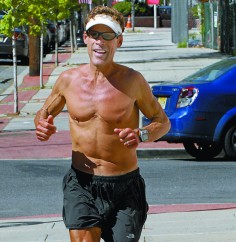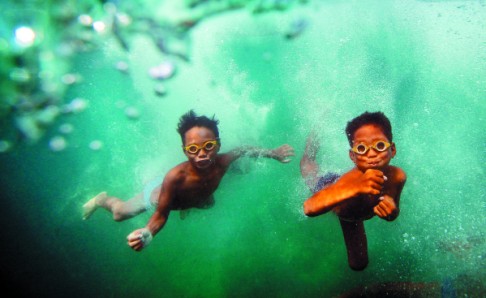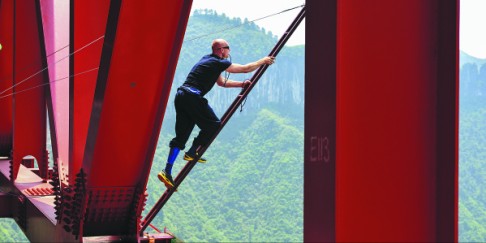
Marked with an X: real-life X-Men
Who among us hasn't pondered which superpower they would have, given the choice? Marvel comics ignited our imaginations but real-life 'mutants' are already among us. Jake Wallis Simons reports
In 1963, when comic-book legends Stan Lee and Jack Kirby created the X-Men, they could have had no idea what they had spawned. At the time, Spider-Man, the Hulk and the Fantastic Four were hogging the limelight, and the motley team of mutants struggled to attract a readership.
Fast-forward four decades, and six X-Men films have grossed more than US$2 billion worldwide. Last week, the seventh in the franchise, , was released in Hong Kong.
Clearly the concept of genetically mutated superhumans has captured the popular imagination. In the Marvel universe, mutation allows the X-Men to create ice formations, generate flames or emit "concussion beams". Disappointingly for comic-book fans, there is no equivalent in the real world. But there are a surprising number of people who - by way of genetic mutation - have acquired abilities that could comfortably be classed as superhuman.
In 2006, scientists at Britain's Cambridge University discovered a young Pakistani street performer who was able to cut himself with knives without experiencing pain. Upon investigation, they found that the boy was one of a handful of local people who had a defect in a gene called SCN9A meaning that pain did not flow from the nerves to the brain. Researchers are currently studying whether this may provide the key to treating chronic pain conditions.
Similarly, a biotech company called Chiroscience is developing an osteoporosis drug based on the study of a community in South Africa that has exceptionally strong and dense bones on account of a "bone mass gene".
Earlier this year UCB, a Belgian pharmaceutical company, launched a competition to find more such superhumans, in the belief that their extraordinary genetic make-up could form the basis of new medicines.
"Individuals or groups who exhibited exceptional wound healing warrant further investigation," said Dr Duncan McHale, UCB's vice president of global exploratory development. He is also interested in "those who have consistently displayed exceptional resistance or immunity to infections, or who, after a robust clinical diagnosis, displayed unusually fast or spontaneous disease remission".
This is only scratching the surface. In all corners of the world there are ordinary people with powers that leave mere mortals astonished. Some can swim like fish; some are able to withstand extreme temperatures; others have extraordinary mental powers, and are able to recall every word they have ever read. Perhaps it is only a partial exaggeration to suggest that these are the real-life X-Men.
In 2005, Dana and Neil Hoekstra from Michigan, in the United States, adopted a baby boy called Liam. They understood that he had been born five weeks prematurely and that this might result in poor health as he grew up.

He did not have the protruding belly common to toddlers; instead, he had well-defined abdominal muscles. Before long, he was lifting huge weights, climbing ropes without difficulty and spending evenings at the gym to burn off his excess energy.
Liam was soon diagnosed with a rare condition known as myostatin-related muscle hypertrophy, which is characterised by the absence of proteins that regulate muscle development. It has been suggested the stories of Hercules may have been based on individuals with this condition.
Thankfully, there are no detrimental effects associated with muscle hypertrophy. This leaves nine-year-old Liam free to - as his Facebook page points out - "have fun being a kid".
One of the original characters in the X-Men was Robert "Bobby" Drake, otherwise known as Iceman. His superpower is cryokinesis, which allows him to turn things - even himself - to ice.
As far-fetched as it sounds, in the real word, the Iceman lives. He may not be able to turn everyday objects to ice, but he holds 20 world records related to withstanding the cold, including the longest time in a bath of ice (one hour, 13 minutes and 48 seconds). His name is Wim Hof.
Among the Dutchman's achievements are standing submerged in ice for one hour and 44 minutes; and running a marathon above the polar circle in Finland wearing only shorts. He does a lot of things wearing only shorts. In 2007, he attempted to climb Mount Everest wearing only shorts, but aborted the mission due to a foot injury.
In 2012, an American television programme called tested Hof's abilities. He passed with flying colours. Over a period of 20 minutes in an ice bath, his temperature and heart rate remained completely normal.
Scientists have found that Hof is indeed able to regulate his body functions, raising cortisol levels, repressing the production of cells relating to immune responses and making automatic processes faster and more efficient. He believes his skill is the result of meditative practices and that these can be learnt by anybody. He has even written a book about it.
Science is baffled by Isao Machii, a 40-year-old Japanese practitioner of , the art of the samurai sword. Having trained in swordsmanship since the age of five, he is the holder of several Guinness World Records, including "most sword cuts to straw mats in three minutes"; "fastest 1,000 martial arts sword cuts"; and "fastest tennis ball cut by a sword". To win the latter title, Machii cut through a tennis ball that was travelling at 708km/h.

Most impressive of all, however, is a stunt he performed in Los Angeles in 2011. An airgun fired a 5mm plastic pellet at Machii, at a speed of 320km/h. At this speed, it is impossible for the human eye to track an object of this size and for the human reflexes to respond. Yet amazingly, he was able to draw his sword and slice the pellet in two while it was in mid-air.
In order for the stunt to be recorded, a specialist video camera was set up and slowed down by 250 times. Psychologist Dr Ramani Durvasula observed the experiment. "He was engaging in anticipatory processing, sort of like Spider-Man," she says. "His form of mindfulness gave him a unique form of anticipatory awareness, which he could bring to a practised task such as slicing the pellet in half."
Some people have suggested that Machii is using a novel type of consciousness to respond with such speed, but the true nature of this power remains unknown.
Dean Karnazes' muscles have extraordinary properties. When the 52-year-old exercises, he never reaches a "lactate threshold" - the experience of intense fatigue as the muscles seize up - because his body clears lactic acid with ultra efficiency. This means he can remain hydrated and functional for remarkably long periods when engaging in feats of endurance.

"At a certain level of intensity, I do feel like I can go a long way without tiring," the American has said. "No matter how hard I push, my muscles never seize up."
His 22-year career includes running 560km in 80 hours and 44 minutes, without sleep; completing a 217km ultra-marathon in Death Valley, California - the lowest and driest region in North America - in temperatures of 49 degrees Celsius; and, in 2006, running a marathon in each of America's 50 states on 50 consecutive days. Some believe that as long as he is properly fed and hydrated, Karnazes could run continuously at a speed of 16km/h until he "dies of old age". In addition to extreme running, Karnazes spends his time giving motivational speeches and doing charity work. His remarkable abilities have even earned him a place on magazine's list of 100 most influential people.
Strangely, Karnazes did not embark on his journey until 1992.
"I wasn't even aware of my 'gift' until a TV show did a scientific study on me," he says. "My belief is that there are people like me walking around all over the place, they just don't know they have such powers. Until you test yourself you may be just as naive as I was."
The Bajau Laut people, of Southeast Asia, are nomads who spend their entire lives on the ocean. They live in houseboats or in stilt villages built on top of coral reefs almost a mile out to sea. Known as "sea gypsies", the Bajau Laut spend 60 per cent of their time submerged in the water, which is equivalent to a sea otter. They are so deeply acclimatised to an aquatic life that when they occasionally spend the night on terra firma, they complain of feelings of "land sickness".
The Bajau Laut are known for their free-diving fishermen. One of them, a man called Solvin, is an expert. On a single breath, he is able to remain submerged for five minutes, descending more than 20 metres to the ocean floor to hunt fish.

Research cited in the BBC's series has shown that, when diving, Solvin's heartbeat slows to 30 beats per minute. His lungs can cope with the air inside them being compressed to a third of its usual volume, and even without weights he is negatively buoyant enough to stride across the ocean floor as if he were on land.
Studies have shown that some Bajau Laut children have eyes that have adapted to the ocean, allowing their underwater vision to be twice as clear as that of other humans. Many intentionally rupture their eardrums in order to assist with equalising. But despite all these adaptations, many members of the tribe have been crippled or killed by the bends.
Eskil Ronningsbakken is blessed with an extraordinary sense of balance, which he demonstrates at lethal heights. Among other stunts, the Norwegian has walked a tightrope between two hot air balloons, balanced on a bicycle on a wire 3,280 feet above a fjord and done a handstand on a pile of chairs balanced on a rock wedged between two other rocks over a 3,500-foot drop.

Scientists have established that Ronningsbakken does not feel fear in the normal way.
"When I'm concentrating, I do not produce excess adrenaline and my heartbeat remains the same," he says. "It is only after the act that the adrenaline becomes activated and I feel a rush."
Astonishingly, Ronningsbakken's heart rate was the same whether he was on solid ground or balancing upside down on the edge of a multistorey building.
The Sunday Telegraph
